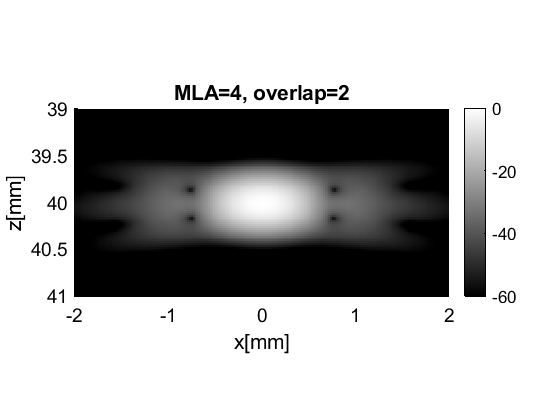FI simulation on a linear array with the USTB built-in Fresnel simulator
In this example we show how to use the built-in fresnel simulator in USTB to generate a Conventional Focused Imaging (single focal depth) dataset for a linear array and a linear scan and show how it can be beamformed with USTB.
This tutorial assumes familiarity with the contents of the 'CPWC simulation with the USTB built-in Fresnel simulator' tutorial. Please feel free to refer back to that for more details.
by Alfonso Rodriguez-Molares alfonso.r.molares@ntnu.no and Arun Asokan Nair anair8@jhu.edu 14.03.2017
Contents
Close all previously opened plots.
close all;
Phantom
We start off defining an appropriate phantom structure to image. Our phantom here is simply a single point scatterer. USTB's implementation of phantom comes with a plot method to visualize the phantom for free!
pha=uff.phantom(); pha.sound_speed=1540; % speed of sound [m/s] pha.points=[0, 0, 40e-3, 1]; % point scatterer position [m] fig_handle=pha.plot();

Probe
The next UFF structure we look at is probe. It contains information about the probe's geometry. USTB's implementation of probe comes with a plot method too. When combined with the previous figure we can see the position of the probe respect to the phantom.
prb=uff.linear_array(); prb.N=128; % number of elements prb.pitch=300e-6; % probe pitch in azimuth [m] prb.element_width=270e-6; % element width [m] prb.element_height=5000e-6; % element height [m] prb.plot(fig_handle);

Pulse
We then define the pulse-echo signal which is done here using the fresnel simulator's pulse structure. We could also use 'Field II' for a more accurate model.
pul=uff.pulse(); pul.center_frequency=5.2e6; % transducer frequency [MHz] pul.fractional_bandwidth=0.6; % fractional bandwidth [unitless] pul.plot([],'2-way pulse');

Sequence generation
Now, we shall generate our sequence! Keep in mind that the fresnel simulator takes the same sequence definition as the USTB beamformer. In UFF and USTB a sequence is defined as a collection of wave structures.
For our example here, we define a sequence of 200 focused beams spanning a lateral range of ![$[-2, 2]$](FI_MLA_linear_array_eq17845419450663549259.png) mm. The focal depth is set as 40 mm. The wave structure too has a plot method.
mm. The focal depth is set as 40 mm. The wave structure too has a plot method.
N=50; % number of focused beams x_axis=linspace(-2e-3,2e-3,N).'; z0=40e-3; seq=uff.wave(); for n=1:N seq(n)=uff.wave(); seq(n).probe=prb; seq(n).source.xyz=[x_axis(n) 0 z0]; seq(n).apodization=uff.apodization(); seq(n).apodization.window=uff.window.tukey50; seq(n).apodization.f_number=1.7; seq(n).apodization.focus=uff.scan('xyz',seq(n).source.xyz); seq(n).sound_speed=pha.sound_speed; % show source fig_handle=seq(n).source.plot(fig_handle); end

The Fresnel simulator
Finally, we launch the built-in simulator. The simulator takes in a phantom, pulse, probe and a sequence of wave structures along with the desired sampling frequency, and returns a channel_data UFF structure.
sim=fresnel(); % setting input data sim.phantom=pha; % phantom sim.pulse=pul; % transmitted pulse sim.probe=prb; % probe sim.sequence=seq; % beam sequence sim.sampling_frequency=41.6e6; % sampling frequency [Hz] % we launch the simulation channel_data=sim.go();
USTB's Fresnel impulse response simulator (v1.0.7) ---------------------------------------------------------------
Beamformer
With channel_data and a scan we have all we need to produce an ultrasound image. We now use a USTB structure midprocess, that takes an apodization structure in addition to the channel_data and scan.
midproc=midprocess.das(); midproc.dimension = dimension.both; midproc.channel_data=channel_data; midproc.scan=uff.linear_scan('x_axis',x_axis,'z_axis',linspace(39e-3,41e-3,100).'); midproc.transmit_apodization.window=uff.window.scanline; midproc.receive_apodization.window=uff.window.tukey50; midproc.receive_apodization.f_number=1.7; b_data=midproc.go(); b_data.plot([],'No MLA');
USTB General beamformer MEX v1.1.2 .............done!

The image is ok, but we can use multiline acquisition (MLA) to improve resolution. We choose to use MLA = 4 and we define a new scan where we increase the number of scan lines by a factor of 4. We also need to tell the apodization function that we will use MLA = 4 scheme.
MLA = 4; midproc.scan=uff.linear_scan('x_axis',linspace(-2e-3,2e-3,MLA*N).','z_axis',linspace(39e-3,41e-3,100).'); midproc.transmit_apodization.MLA = MLA; midproc.transmit_apodization.MLA_overlap = 0; b_data=midproc.go(); b_data.plot([],'MLA=4, no overlap');
USTB General beamformer MEX v1.1.2 .............done!

Mmmm... Somewhat better. But we see a strange artifact between each MLA group. We can mitigate this effect introducing some MLA overlap
midproc.transmit_apodization.MLA_overlap = 2;
b_data=midproc.go();
b_data.plot([],'MLA=4, overlap=2');
uff.apodization: Inputs and outputs are unchanged. Skipping process. USTB General beamformer MEX v1.1.2 .............done!
